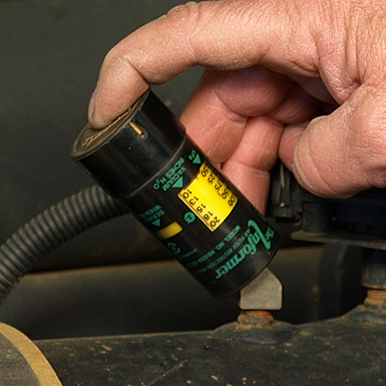We are often asked how well our air filters clean the air supplied to the engine for combustion. This may be when customers are looking to improve their current air cleaner.
A common question is: "what micron rating is it?". However, a micron rating is an efficiency measurement used for liquid filters and not used for describing air filter efficiency.
Air filter elements are evaluated using an industry wide standard (ISO5011) and their performance is expressed as an efficiency level.
This efficiency level is determined by feeding air containing a known concentration of standard test dust into the air cleaner until the filter reaches the end of its life. This end of life is when the restriction reaches a predetermined level. The use of a standard test dust ensures consistency and is representative of the size range of dust particles found in real conditions.

When the filter reaches the end of its life, the weight of the dust on the filter is considered the capacity of the filter. Any dust, which passes the filter, is captured by an absolute filter down stream of the air cleaner in the test laboratory.
The weight of the dust captured by the absolute filter is compared to the weight of the dust fed into the air cleaner. The difference between them is the efficiency of the filter expressed as a percentage.
The efficiency of an air filter will increase as dust accumulates on the filter surface, right up to the point at which it needs to be replaced. This is why it is important to allow an air filter to do its job properly and not change it prematurely. In other words, an air filter that is allowed to reach the end of its life will work better than filters that are changed more often.
Measuring the Percent of Particles Trapped by the Filter
These dust vials show the actual amount of fine test dust that passes through the air filter media for every one kilogram of dust fed to the air filter, which is equivalent to 100 hours* of equipment operation.
Donaldson Blue® Ultra-Web® HD Filter Media

Donaldson Blue® Ultra-Web® Filter Media

Donaldson Standard Filter Media

Will-fit Standard Filter Media

Will-fit filters can allow up to 100 times more dirt to pass through the filter into the engine than Donaldson Blue air filters with Ultra-Web filter media.
Did You Know?
Donaldson air filters in Donaldson air cleaner housings have a minimum overall efficiency greater than 99.90%. The efficiency of the filter actually improves as dust accumulates on the surface of the filter, so an air filter gets better as it gets used.
So how do you determine when the filter has reached the end of its life?

Don’t judge a filter by its appearance! The only practical way is to measure the restriction level, using a restriction indicator or gauge. All combustion engines are designed to operate with some restriction, and the manufacturer will specify the maximum acceptable level for their engine. This is the point at which you should change your filter. The condition of an air filter cannot be determined by its appearance.
Get the maximum protection for your engine and save money by allowing your air filter to work for its entire filter life.

Understanding Air Filter Efficiency




